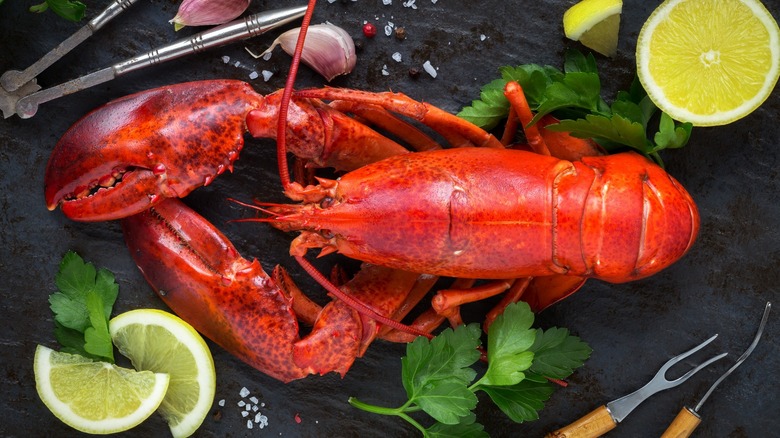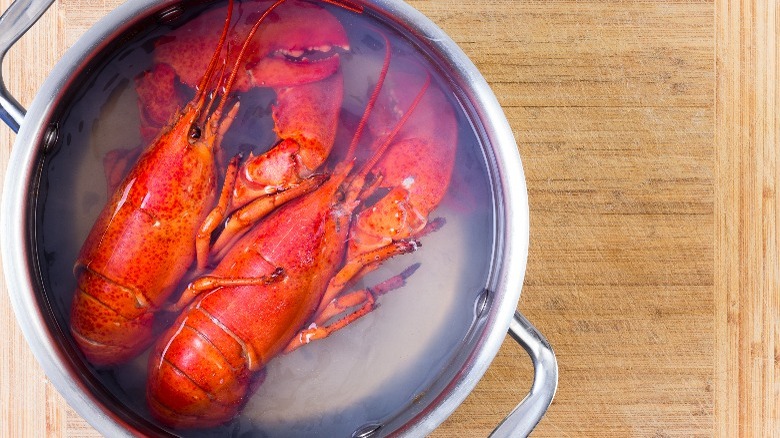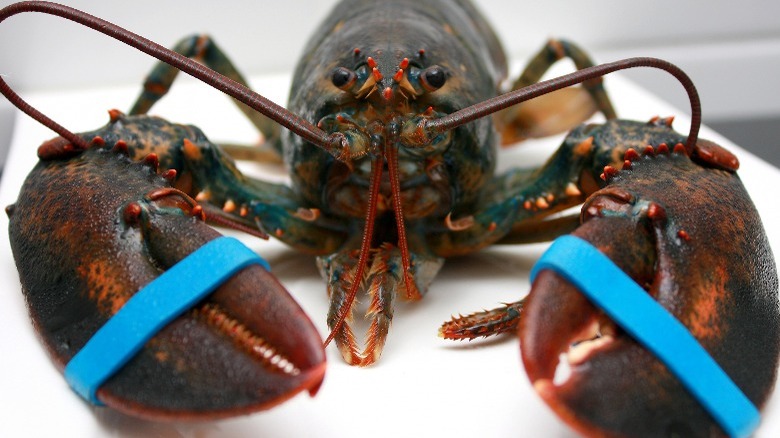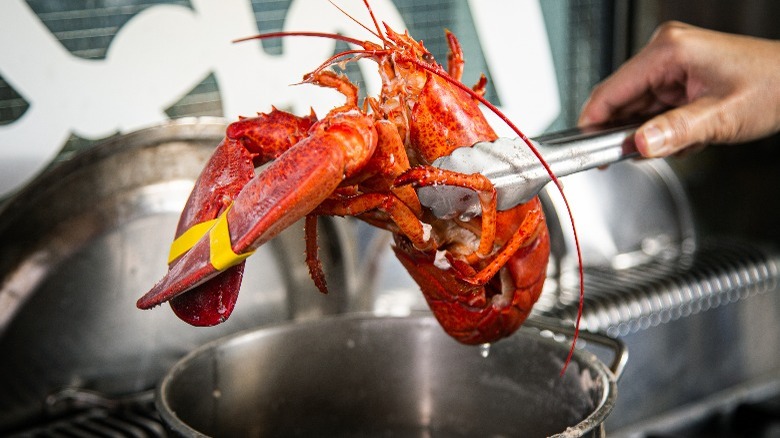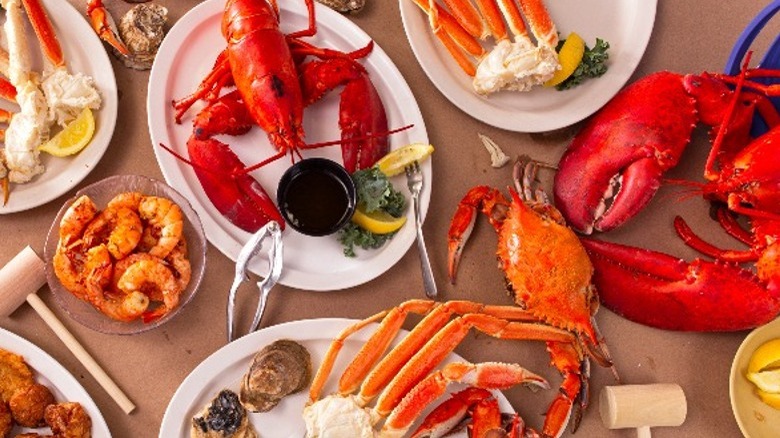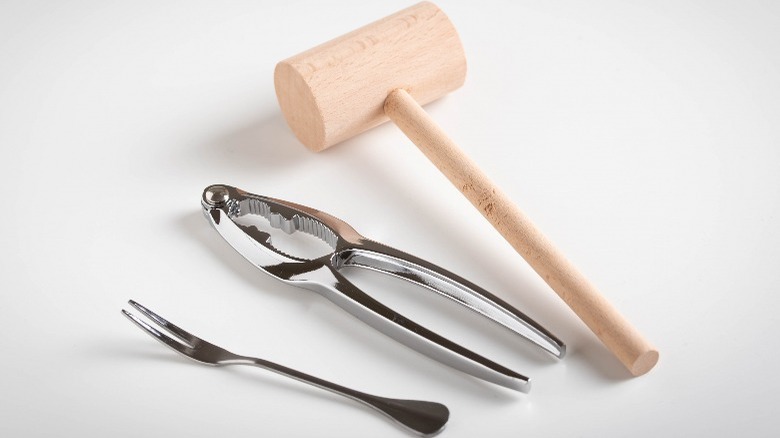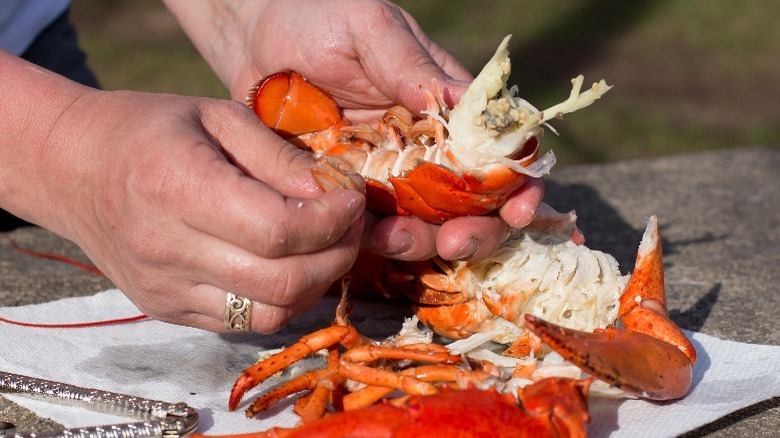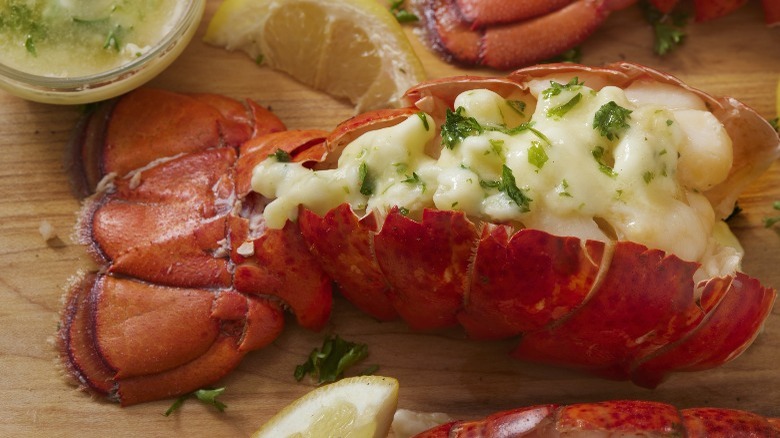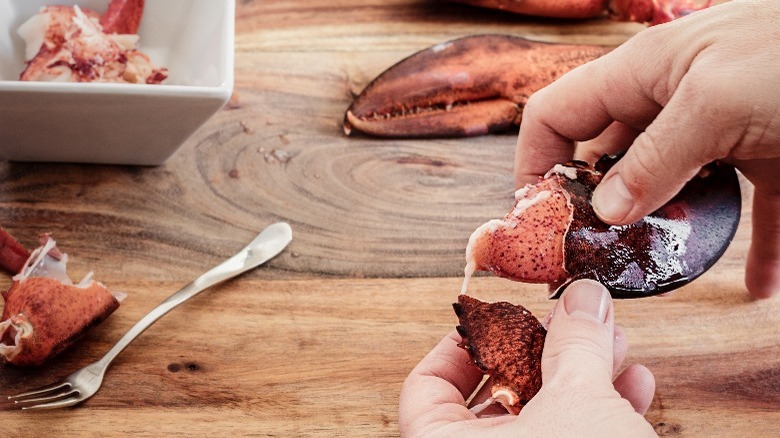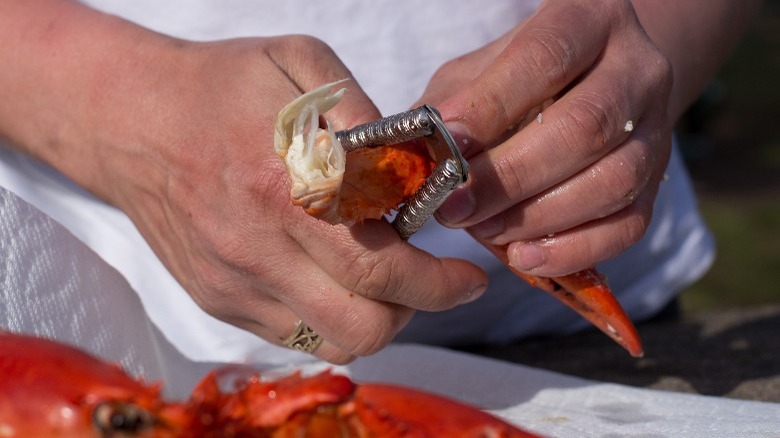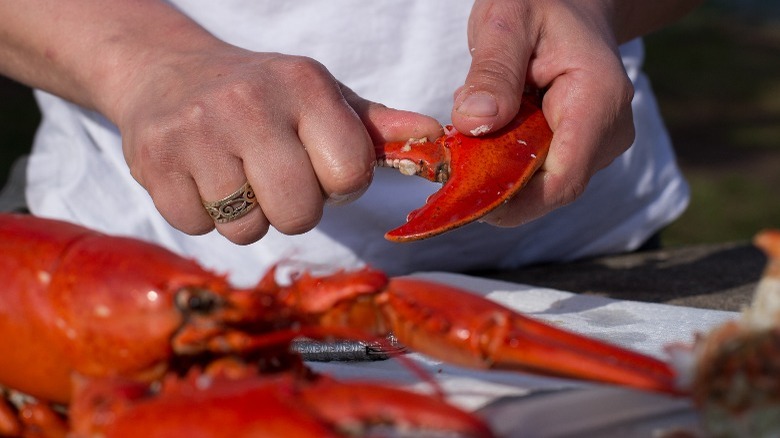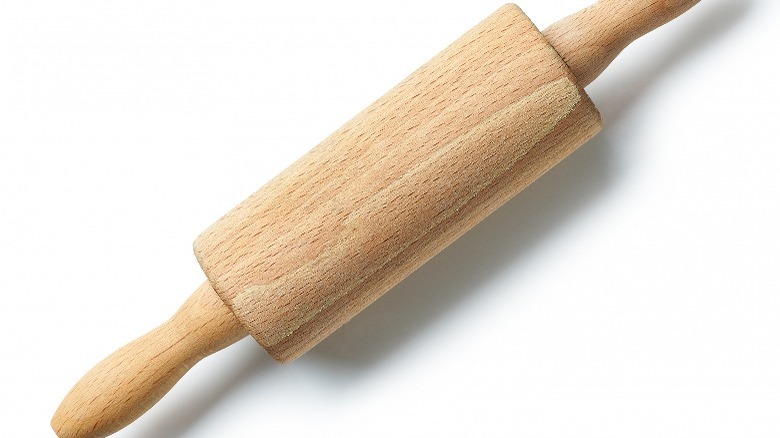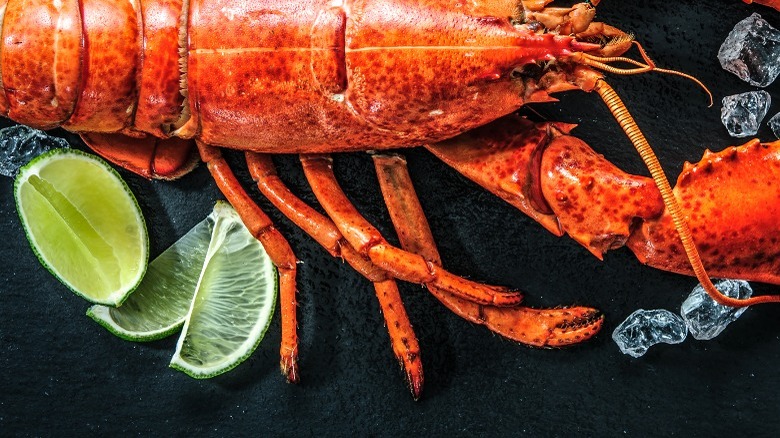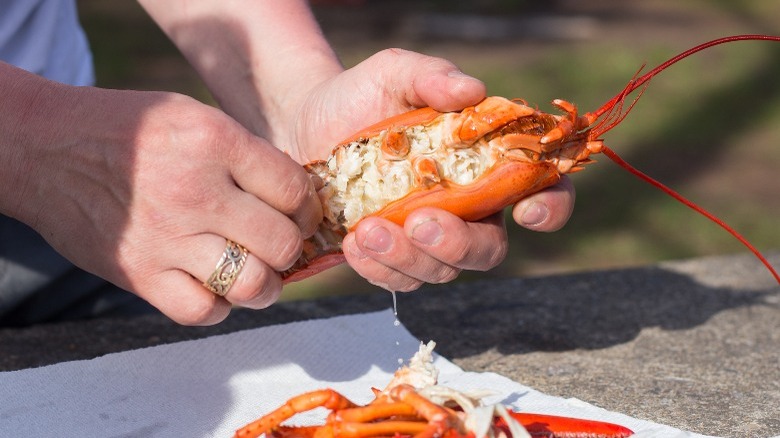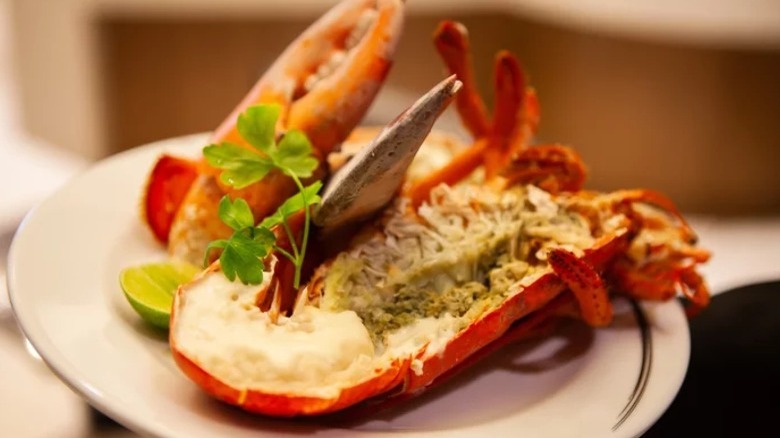14 Best Tips For Removing Lobster Meat From Its Shell
There is nothing quite as soul-satisfying as sinking your teeth into a hot buttery lobster roll, with the picturesque view of slapping waves before you. If there is one place you can get the whole packaged deal, it's up north, along the coast of Maine, where lobster is prevalent.
We love a lazy lobster meal prepared for us, but using your hands to break open steaming hot shells feels so primal we swear the meal tastes better because of it. Here's the thing, though — it's a laborious task. Without the right tools in place and knowledge at hand, your first de-shelling experience might feel a bit trying.
That's why we contacted expert Billy King, who has worked in the commercial fishing industry for over 23 years. Between working the stern of a lobster boat for several seasons, to running a tight ship along the Atlantic as a First Mate, King has had his fair share of breaking shells while living in the beautiful state of Maine.
With the lobstering season in full swing, King was kind enough to give us some of his time so we could learn a few tips for removing lobster meat from its shell.
Know the difference between soft shell and hard shell
Before running off to the fish market and making your selection along the lined lobster tanks, you'll want to know about the difference between soft-shell and hard-shell lobsters. In the state of Maine, it's no secret among Mainers that most tourists find themselves selecting the biggest, baddest-looking lobster in the tank, but you might not be so lucky in the flavor category, and we'll explain why.
No matter what lobster you select while visiting the vacationland state, you're bound to delight in the sweet buttery flavor that comes with the luxury of a fresh lobster lunch. However, it doesn't take a fine-tuned set of taste buds to quickly taste the difference between soft-shell and hard-shell lobster meat.
King explained that every year as the water warms up, lobsters tend to get too big for their shells, so they grow themselves a new soft shell and break away from their old hard shells. This time of the year marks an exciting season for seafood gourmands who appreciate the superiority of smaller, soft-shell lobsters. Not only do they taste sweeter and more buttery, but they are much easier to break open too.
Remove the bands right before steaming
In the world of culinary arts, you'll find a myriad of regional food battles that seem to go on for decades without any clear indication of who is right and who is wrong. Examples include whether or not cornbread should be sweet or savory or whether or not ketchup belongs on certain foods. Like most other disputes, the "right" way of doing things is often a matter of preference and what you've been taught over the years.
The same thing goes for whether or not you should remove rubber bands before steaming your lobsters. Some claim the flavor is altered when bands are left on, while others argue there is no difference in taste.
The bands are placed over the lobster claws for safety and the risk of mean pinches. If you are all about removing the bars, King recommends only removing them before steaming. That's because the lobsters will fight one another and could cause shell breakage. For pristine lobsters with legs and shells fully intact, you'll appreciate waiting until right before to remove them. Otherwise, consider keeping the bands to prevent your fingers from getting pinched.
Always steam your lobster
If you've never cooked a whole lobster before, you might wonder what the best method might be. Even though many say boiling your lobster is the best or only way to cook it, we're here to tell you that that would be a mistake, so don't bother filling your giant pot to the top.
When you submerge a lobster in boiling water, you are risking an overdone lobster that lacks flavor. Overcooked lobster turns the meat into a hard rubbery texture that is unpalatable. Don't pay all that money to waste it on flavorless rubber. Instead, use a gentle steaming method. All you need is an inch or two; then, you are good to go.
King recommends steaming your lobster in salt water, using sea salt. Not only will you reach more tender results, but you'll appreciate the sweetness without the worry of weakening the lobster's immaculate flavor.
Set your stations up ahead of time
Most know lobster to be a luxury ingredient and a meal only indulged in occasionally due to the expensive costs associated with these crustaceans. The thing about lobster, though (no matter how lavish you may call it), is that cracking open the shells is a wet and sticky job.
If there is one thing King made sure to tell us about breaking open lobster shells, it is that "the job is messy." Between fighting through tricky cracks, to hot lobster juice gushing out, your hands are bound to get wet and unclean. Then again, something primal within us gives us joy in using our hands unmannerly to rip open a freshly caught dinner that sits before us.
Before you steam your sea creatures to a bright red hue, you must set your dining table up for success. Each guest eating lobster will need a plate with large bowls scattered throughout the table for disposing of shells. Plenty of napkins are a must, but offering hot damp cloths for sticky wet hands is a nice touch too. You'll also need drawn butter placed in small ramekins for dipping. Don't forget to equip all your guests with the correct tools, too.
Use the correct tools
Now that you know which lobsters boast the most succulent meat and you understand the importance of setting up your stations before, we're almost ready to dig in. But first, there is one more thing you should know about being prepared — and it's all about having the right tools at hand.
The most common tools for cracking shells are the shell cracker and lobster pick, which help remove tiny pieces of precious meat. King mentioned that having a mallet can be helpful but that your two hands are your most important tool for getting the job done.
Kitchen shears can be awful handy, too, depending on which part of the lobster you might be working on. A small rolling pin is one tool you might not have thought to use. This will come in clutch when it's time to remove tiny bits of meat from the legs.
Start with the tail
Once your lobsters have cooked long enough, you'll notice the shell turns bright red. Use a set of long tongs to remove each lobster before letting them cool for a few minutes before digging in. The lobster's tail and claws are the most sought-after meat, so folks usually go right for the gold. Because you'll get most meat from the tail, we say start there. King explained that the simplest way to remove the tail from the body is by grabbing hold of the tail, then twisting and pulling it from the body.
From there, you can fold it in and crush the tail along the length to help release the meat. The flipper end can be removed, allowing you to push your finger through one side. This should help the meat come out smoothly in one piece. A set of kitchen shears can alternatively be used to cut the underside of the tail before opening it up and removing the meat.
The flippers have some seriously tender meat too
If there is one thing you should know about removing lobster meat from its shell, it's that there are lots of hidden pockets of edible stuff you might not know about. As long as you are willing to throw in a little elbow grease, you are bound to find lots of precious treasures within.
That's why you don't want to throw your shells in the bowl until you have removed every morsel of meat. One place many don't know to look is within the flippers of the central and outer tail fins of the lobster located at the far end of the tail. King told us about this little secret location where lobster meat is sweet and lovely to eat.
To remove the flipper meat, carefully twist and pull away each tail fin. What usually stays behind is a tiny sliver of seriously tender and delicious lobster meat. Some people don't bother with it, while others don't even know to look for it — but if you're all about savoring every bite, we say go for the flippers.
Use your fingers to push meat through
As you work through your lobster meat, you'll find a natural tendency to want to pull lobster meat out. Unfortunately, there is an issue with this approach, mainly depending on which location you are removing meat from because some meat is so delicate. The lobster tail is often chewier and heartier than the claws, knuckles, and legs. Therefore you will be able to get away with pulling meat out of this area.
The knuckle, claws, and legs are far more delicate than the tail, so using your fingers to pull the meat out might not work so well. Instead, consider finding openings to push your finger through. This method works well for removing meat without breaking it into pieces.
After cracking the shell, find a large enough opening to push your index finger within the body to help remove anything edible. If your fingers are too big, use a lobster pick or one side of lobster crackers to push the meat through.
Use the crackers (or shears) for the knuckles
The tail and claw are a lobster's two most prized parts because that's where most of the meat is. If you are a claw person, then you know all about the neighboring attached knuckles, where you'll find some additional meaty gold within.
The knuckles are essentially like the "arms" of the lobster found between the claw and the lobster's body. There you will discover wee morsels of tender meat that are tricky to find and remove without the right tools.
After tearing the knuckle from the body and claw, use your crackers to break the shell along the knuckle's length. This will help you gain easy access before scooping out some of that good stuff. Alternatively, kitchen shears should have no issue cutting through the shell before opening it up to find what's inside. Both methods work well depending on what tools you have on hand.
Pull the pincher claw back for easy claw meat removal
During your lobster shell cracking adventure, you'll find nothing quite as satisfying as succeeding in removing one whole piece of lobster without breaking it along the way. We were curious about how to remove the meat from a lobster claw without damaging it, so we had King chime in on details.
King explained that there are two parts to the lobster claw. The large section is called the "crusher claw," and the little area is called the "pincher claw." Both hold meat that will stay intact and come out as one piece if you work carefully.
Start by breaking the small pincher claw outward and twisting until the cartilage comes out clean. Place the crackers in the center of the crusher claw, then press down to break the shell without crushing the meat inside. You should be able to separate the shell in half without damaging what's inside. Use your fingers to push the meat out gently.
Use a rolling pin to squeeze leg meat out
There is a lot of buzz out there regarding lobster leg meat and whether or not you should bother picking it out to eat. Most lobster shacks and restaurants won't bother with removing leg meat, considering how laborious and time-consuming it may be, but if you're savoring every bite, we say go for the legs.
One lobster is born with ten legs — whether or not it comes to your table with ten is a matter of whether or not it recently lost one in a furious fight with another lobster. If you have a recipe that calls for lobster meat, and you've decided to steam a few up and remove the meat yourself, then be sure to grab your kitchen shears and a rolling pin.
Remove each individual leg, then snip right above the joint. Use your rolling pin to squeeze out any meat within the lobster's leg. It might not be a lot of meat, but every piece counts if you ask us.
Your teeth make great leg meat removers too
If you're at a table dining with friends, a rolling pin might not be the most appropriate tool to remove those legs. With limited space thanks to the loads of plates, bowls, and cracking tools, a rolling pin might seem like a silly addition to bring out.
Instead, consider using your teeth to remove the meat. Remove each leg, then break away at the joint. From there, use your teeth to press down and squeeze out whatever you can from the inside. We know this might look a bit caveman-ish, but hey, we told you eating lobster is a messy game.
If you don't like using your teeth to squeeze out the good stuff, you can also try using a lobster pick to fish out the protein within. The idea is to do your best not to leave behind any of that sweet stuff!
Don't ditch the body
Before you decide to move on to a second lobster, make sure you do a little digging within the main body of the lobster. Believe it or not, there is a decent amount of hidden little nibbles of rib meat within the cavity.
Flip the body upside down so that the inside portion is open. Inside the cavity, you will notice the body has thin shells filled with morels of tasty meat. Use your finger or the lobster pick to fish out all the scraps you can find. One way to enjoy this in one bite is by scraping all the meat into your butter-filled ramekin. Once you have removed it all, spoon the lobster meat out of the dish, drain most of the butter, and enjoy one big Lucious buttery bite.
After you have finished scooping out the rib meat, add the remainder of your shell to the shell bowl. Don't throw them out, though! You'll want to save all your shells to make a rich and flavorful lobster stock that can be used to make bisque or risotto.
Save the Tomalley
If it is your first time eating a whole lobster, you might wonder what to do with the green stuff (called tomalley) found within the lobster's body. We totally understand it might look a little unsightly or unappetizing but trust us when we say it is exquisite.
Do not get rid of the tomalley. Instead, you can enjoy it in a few different ways. The intensely flavored green stuff, which boasts a paste-like consistency, can be enjoyed with each bite of lobster or stirred into soups or sauces. Otherwise, mix it in with melted butter and use that to dip your lobster in.
If you plan to make lobster mac and cheese, or some sort of lobster alfredo, you will surely appreciate the amped-up flavor that comes with adding tomalley to your sauce. King said he enjoys tomalley mixed with butter and spread on crackers or toast. The possibilities are all yours.
